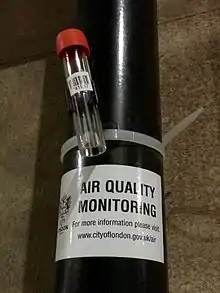Diffusion tube
A diffusion tube is a scientific device that passively samples the concentration of one or more gases in the air, commonly used to monitor average air pollution levels over a period ranging from days to about a month.[1] Diffusion tubes are widely used by local authorities for monitoring air quality in urban areas,[2] in citizen science pollution-monitoring projects carried out by community groups and schools,[3][4] and in indoor environments such as mines[5] and museums.[6]
Construction and operation

A diffusion tube consists of a small, hollow, usually transparent, acrylic or polypropylene plastic tube, roughly 70mm long, with a cap at each end. One of the caps (coloured white) is either completely removed to activate the tube (in the case of nitrogen dioxide sampling) or contains a filter allowing in just the gas being studied. The other cap (a different colour) contains metal mesh discs coated with a chemical reagent that absorbs the gas being studied as it enters the tube.[7] Tubes that work this way are also known as Palmes tubes after their inventor, American chemist Edward Palmes,[8][9] who described using such a tube as a personal air quality sensor in 1976.[10]
During operation, the tube is opened and vertically fastened with cable ties to something like a lamp-post or road sign, with the open end facing down, and the closed, coloured cap at the top. The gas being monitored, which is at a higher concentration in the atmosphere, diffuses into the bottom of the tube and is quickly absorbed by the chemical cap. Since it's absorbed, the process of diffusion continues. After a fixed period of time (typically from two weeks to a month), the tube is sealed up and sent away to a laboratory for analysis. The atmospheric concentration of the gas being studied can be calculated using the amount captured and Fick's laws of diffusion.[11]
Diffusion tubes can be used to sample various different gases, including oxides of nitrogen (nitrogen dioxide and nitric oxide), sulphur dioxide, ammonia, and ozone. Although tubes sampling these gases all work through the same process of molecular diffusion, there are important differences. Nitrogen dioxide tubes use triethanolamine, TEA, as the absorbing (reagent) chemical, for example, while hydrogen sulphide tubes are opaque (rather than transparent) to prevent ultraviolet light from degrading the chemicals inside. Some types of tube can sample multiple gases at the same time.
Advantages and disadvantages
Diffusion tubes are reasonably accurate, relatively cheap, easy to use, extremely compact, passive (they need no power source), and have a fairly long shelf life; with careful positioning, they can be deployed more or less anywhere, indoors or outdoors.[6][12] They give a reasonable indication of the long-term, average concentration of a pollutant gas, such as nitrogen dioxide, and they make it easy to compare average pollution levels in different places or at different times. Often, a series of tubes are mounted in exactly the same place for consecutive months of the year to enable longer-term comparisons of pollution levels. It's also common for local authorities to mount a number of tubes in different places over the same time period so pollution hotspots in towns and cities can be identified.
Since diffusion tubes are designed to be left in place for days or weeks at a time, they don't indicate shorter-term fluctuations of the pollutant being studied, such as the rising and falling levels of gas during the day, the difference between one day and the next or between weekdays and weekends, or the number of times guideline pollution levels are exceeded while they're in place. They're also much less accurate than the highly sensitive, automated monitoring equipment used in roadside pollution monitoring cabins. Sources of inaccuracy include air turbulence (caused by things like wind movements or air conditioners), pollution from building ventilation systems, ultraviolet light (theoretically absorbed by the plastic tube), and other pollutants.[7]
References
- Nash, David G.; Leith, David (February 2010). "Use of Passive Diffusion Tubes to Monitor Air Pollutants". Journal of the Air & Waste Management Association. 60 (2): 204–209. doi:10.3155/1047-3289.60.2.204. eISSN 2162-2906. ISSN 1096-2247. PMC 2838214. PMID 20222533.
- "Local Air Quality Management Technical Guidance (TG16)". Local Air Quality Management. UK Government Department for Environment and Rural Affairs. April 2021. Retrieved 28 February 2022.
- "Using Diffusion Tubes". Care4Air. Sheffield City Council. Retrieved 28 February 2022.
- "Diffusion Tubes". LoveCleanAir South London. Retrieved 28 February 2022.
- Pederson, Jerald, ed. (1985). Bureau of Mines Research. U.S. Department of the Interior. p. 13.
- Grzywacz, Cecily (2006). Monitoring for Gaseous Pollutants in Museum Environments. Getty Conservation Institute. p. 48. ISBN 9780892368518.
- Targa, Jaume; Loader, Alison. "Diffusion Tubes for Ambient NO2 Monitoring: Practical Guidance for Laboratories and Users" (PDF). Local Air Quality Management. UK Government Department for Environment and Rural Affairs. Retrieved 28 February 2022.
- Brooks, Bradford; Davis, William (1992). Understanding Indoor Air Quality. CRC-Press. p. 110. ISBN 9780849388460.
- Sella, Andrea (1 November 2016). "Palmes' Tube". Chemistry World. Royal Society of Chemistry.
- Palmes, E; Gunnison, A; DiMattio, J; Tomczyk, C (1976). "Personal sampler for nitrogen dioxide". American Industrial Hygiene Association Journal. 37 (10): 570–577. doi:10.1080/0002889768507522. PMID 983946. Retrieved 28 February 2022.
- Plaisance, H (2004). "Response of a Palmes tube at various fluctuations of concentration in ambient air". Atmospheric Environment. 38 (36): 6115–6120. Bibcode:2004AtmEn..38.6115P. doi:10.1016/j.atmosenv.2004.08.011. ISSN 1352-2310. Retrieved 28 February 2022.
- Boleij, J; Lebret, E; Hoek, F; Noy, D; Brunekreef, B (1967). "The use of Palmes diffusion tubes for measuring NO2 in homes". Atmospheric Environment. 20 (3): 597–600. doi:10.1016/0004-6981(86)90103-4. ISSN 0004-6981. Retrieved 28 February 2022.